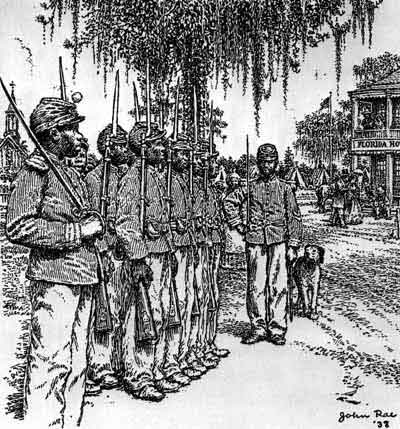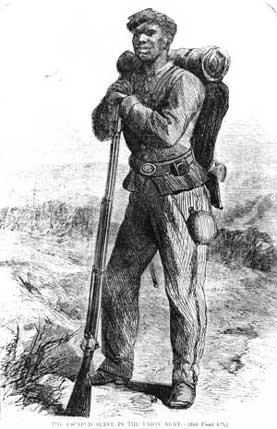

|
The 35th United States Colored Troops (U.S.C.T.) was one of only two regiments in Montgomery's Brigade. Unlike its more famous partner, the 54th Massachusetts, the 35th U.S.C.T. had not yet experienced combat. Organized in New Berne, North Carolina and Virginia during the summer of 1863 as the First North Carolina Colored Volunteers, the unit had participated in siege operations against Charleston, primarily as laborers and garrison troops.
The First North Carolina Colored Volunteers was redesignated as the 35th U.S.C.T. on 8 February 1864. However, the news of this did not reach the regimnent until after the Battle of Olustee. Even then, many of the officers and men, as was common in military units throughout history, continued to refer to their unit by its original name for a period of time. There are numerous official reports existing in the archives, or in the hands of private individuals, in which correspondance from the unit continues to identify it as the 1st North Carolina Colored Volunteers. The earliest known, at least to the Olustee CSO, report from the unit that identifies it as the 35th U.S.C.T., is dated 10 May 1864. However, as most official Civil War histories and Web sites identify the unit as the 35th U.S.C.T., this site will use that designation as the official designation, except where called otherwise in historial documents. Most of the 35th's enlisted men were ex-slaves from coastal areas of Virginia and the Carolinas, while its officers came from various northern units. Colonel James Beecher commanded the regiment. A half-brother of Harriet Beecher Stowe and Henry Ward Beecher, James drifted through various occupations during his early years, including a stint as a missionary in China. Labeled "The Odd One" by a biographer of the Beecher family, James seemed an unlikely candidate to command a regiment in combat, but he had previously served ably as lieutenant colonel in the 141st New York Infantry, and proved an efficient administrator and trainer during the unit's early months. At Olustee, the 35th U.S.C.T. was commanded by its second-in-command, Lieutenant Colonel William Reed, as Colonel Beecher was on leave in the north when the Florida campaign began. As such, its new temporary second-in-command at Olustee was Major Archibald Bogle, formerly of the Seventeeth Massachusetts and in civilian life a druggist from Melrose, Massachusetts. Bogle's father was "known to fame as the proprietor of 'Bogle's Magic Hair Dye'," and a contemporary wrote that Bogle "always used the stuff on his moustache and hair, and kept them in shape if his person was otherwise seedy." |
The 35th U.S.C.T., like the 8th U.S.C.T. and several of Seymour's other regiments, had not participated in a major battle, and represented a question mark for the Federal commander. For the campaign to be successful, these green units would have to perform well in combat.
At Olustee, the 35th U.S.C.T. lost 230 men while, along with the 54th Massachusetts, covering the retreat of the Federal army, Lieutenant Colonel Reed was wounded during the battle, and later died of his wounds while in hospital in Beaufort, South Carolina, on 27 February. Major Bogle was also gravely wounded, but was captured by the Confederates. His adventures afterwards (see links below) are a fascinating tale of mistreatment, imprisonment and survival.
 |
 |
During the rest of 1864–1865 the unit garrisoned positions in South Carolina and Florida and fought in several smaller engagements, including those at Black Creek and St. John's River. The 35th participated in the Battle of Honey Hill, South Carolina, on 30 November 1864. According to Luis F. Emilio, a captain in the 54th Massachusetts and author of A Brave Black Regiment:
"Although it is difficult to establish the relative time of events, these dispositions having been made, the Thirty-fifth United States Colored Troops, Col. James C. Beecher, charged up the road. It went up the road with a cheer, but receiving a terrible fire, after severe loss, was forced to retire and form in support of the artillery. At one time that day Colonel Beecher, Thirty-fifth United States Colored Troops, who was wounded, came along in the rear of our line in a dazed sort of way. Fearing he would be killed, Lt. Col. Hooper sent two men to assist him to the rear." (Brave Black Regiment, p. 250)
There are numerous references to the 35th in A Brave Black Regiment. It was involved in the Devaux's Neck operations immediately after Honey Hill although it does not appear from Emilio that they engaged the enemy.
Emilio's final reference to the 35th involves a racial meleé with the 127th New York while on occupation duty in Charleston. According to Yacavone's A Voice of Thunder, the 127th and 165th New York were especially virulent racists taking every opportunity to attack Charleston blacks and black Union troops. At one point, General Gillmore had the 165th confined to Ft. Wagner and threatened to take away their colors. The Charleston area, apparently, was in a Bosnia-like situation at the close of the war. Blacks were victimized at every turn both by ex-Rebs and Union whites.
Like many other men in the colored regiments, those in the 35th used their spare time to improve themselves by learning to read and write. Frances Beecher, wife of Colonel James Beecher, commander of the 35th U.S.C.T., taught many men of this regiment to read and write while they were stationed at Beaufort and Jacksonville. She later wrote:
" "My mornings were spent in teaching the men of our regiment to read and write, and it became my pleasing duty and habit, wherever our moving tents were pitched, there to set up our school. Sometimes the chaplain assisted, and sometimes the officers; and the result was that when the men came to be mustered out each one of them could proudly sign his name to the pay-roll in a good legible hand. When enlisted, all but two or three of them were obliged to put a mark to their names as written by the paymaster, thus:
his
John X Jones
mark"While their eagerness to learn and the difficulty that many found in learning were touching. One bright mulatto man particularly worked at his letters for two years, and then could only write his own name; while others learned at once. Whenever they had a spare moment, out would come a spelling-book or a primer or Testament, and you would often see a group of heads around one book." (from The Negro's Civil War by James McPherson)
The 35th U.S.C.T. mustered out of service on 1 June 1866.
"There have been men who have proposed to me to return to slavery the black warriors of Port Hudson & Olustee to their masters to conciliate the South. I should be damned in time & eternity for doing so." - Abraham Lincoln, April 19, 1864 (Collected Works 7: 506-507)
Article in the Worcester Aegis and Transcript on the First North Carolina (Colored) Volunteers.
Information on LtCol William Reed
"Death" of Major Archibald Bogle
The 'Further Adventures' of Major Archibald Bogle
Death of Capt Charles Jones
1st Lt John Darling Terry, Medal of Honor awardee
Pvt Jordan Swindel, Company H
Early known use of "35th U.S.C.T." by unit
Excerpt from the book The Black Phalanx
External Web sites related to the Battle of Olustee
History of the 35th U.S.C.T
35th United States Colored Troops
Service record of the 1st N.C. Colored Volunteers/35th U.S. Colored Troops
Short history of James Beecher
The story of the 35th U.S. Colored Troops
Database of United States Colored Troops
Reference books on the 35th U.S.C.T
Appreciation is extended to Rob Goldman for providing the history of the 1st N.C.C./35th U.S.C.T. after its participation at the Battle of Olustee.
?
Union Order of Battle
Battle of Olustee home page
http://battleofolustee.org/